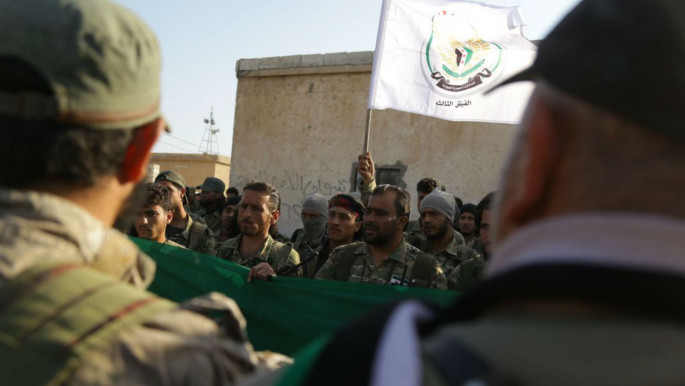What will be the future of the Syrian Democratic Forces?
During the massive inflow of criticism, some important question have arisen: What happened to the multi-ethnic Syrian Democratic Forces (SDF) and the trained local Internal Security Forces the Pentagon asked the US taxpayers to pay for? And what will be the future of the SDF?
Operation Inherent Resolve's report to the US Congress on June 30 2019 states that, "The end strength for these main partner forces this quarter was around 100,000. According to CJTF-OIR, the desired end strength is 110,000, consisting of: 30,000 SDF, 45,000 PRISF [Provincial Internal Security Forces], and 35,000 InSF [Internal Security Forces]."
The report explains the nature of Internal Security Forces by stating that "these forces are drawn from the local communities and reflect the ethnic composition of the areas where they are based."
Read also: Some Syrians are fleeing Turkey's offensive, others are returning home
If Centcom officials and the Pentagon were telling the truth to the American Congress, why are former Centcom officials propagating the betrayal of Syrian Kurds who have argued that the SDF are a multi ethnic group for years?
 |
|
| Read also: Syria Weekly: Syria's north is up for grabs as Turkey offensive begins |
Overnight, the same who propagated the SDF as a multi ethnic group changed their language towards one ethnic group labelling all Kurds as SDF/YPG and rejecting the Kurdishness of all Kurds who don't cooperate with the YPG. Either today, Centcom officials and the propagandists of the YPG are fooling the world or they were fooling the world in the past.
Actually the reality is in between. The SDF is a multi ethnic group but no structure is allowed except the YPG. The veterans from the Qandil Mountains were in charge of every single aspect of the SDF.
Even the overall commander, Ferhat Abdi Sahin alias Mazlum Kobane, is a PKK veteran. He was adopted by the founding leader of the PKK and conducted terror attacks in Turkey for 28 years before he became a prominent figure in the SDF. He is been wanted in Turkey for the killing of 41 civilians and the wounding of over 400.
The Arab elements in the SDF were used as make-up, portraits and distributors of the decisions of the YPG leadership. Arab factions such as Jaysh Thuwwar al-Raqqa or Ahmad Jarba's Elite Forces who tried to maintain an autonomous role within the SDF were disbanded and crushed by the YPG.
 |
|
A future for the Syrian Democratic Forces
Under current circumstances, the dreams of the PKK to establish a communist state based upon the 'democratic confederalism' model of Abdullah Öcalan seems vanished.
The 'most effective forces' in Syria as Centcom officials used to describe them collapsed incredible fast. Seeing to have no chance against the joint Syrian-Turkish military operation, the YPG went to the Assad regime and announced a deal to hand over areas to the regime. By doing so, the YPG aimed to prevent a further push from the Turkish Armed Forces and the Syrian National Army but their attempt failed. Additionally, the Assad regime has not officially confirmed the deal as of the time of writing.
The deal by the YPG opens a big question for the residents of currently YPG-held areas, most of whom fear the Assad regime. Many civilians and SDF members, especially Arabs, are on the terror list of the Assad regime. They expressed their fears and dissatisfaction with the decision by the YPG to hand over areas to the Assad regime. However, there is a way out for the Arab elements of the SDF to survive and prevent to get under the wipe of the regime but it depends mainly on the US.
 |
|
| Read also: Turkey, the Kurds and the demographic re-engineering of Syria |
If the US officials open their eyes, they might seen the new real opportunity emerging out of the current operation in northeast Syria. When the 30km deep safe-zone is being established, the YPG won't be able to be a real actor and will be forced to go underground but the Arab elements and the Internal Security Forces of the SDF won't vanish. Turkey and the Syrian opposition do not view the Arab elements of the SDF as enemies per se. The US can ensure its control over airspace in the south of the safe-zone and mediate between Turkey, the Syrian opposition and the Arab elements of the SDF.
As a result of this mediation, the Arab elements of the SDF could form a new entity; cooperate with the Syrian opposition and Turkey.
In such a scenario, the SDF would over time merge with the Syrian National Army who is the official armed branch of the Syrian Interim Government formed by the Syrian opposition. Such a unity would go from Idlib to Deir az-Zour and control half of Syria, half of Syria's population and almost all of its natural resources and agricultural areas.
The only distinction would be as following: the opposition in the safe-zone would be embedded with Turkish troops; the opposition south of the safe-zone would be under US air protection without any US troops embedded preventing the Assad regime to enter these areas. In such a scenario, the Syrian opposition would be very strong ahead of the start of the constitutional committee and the political transition process.
Nevertheless, if the US doesn't see this opportunity and don't preserve the non-YPG elements of the SDF, the US would let its former partners in Syria to be crushed by the Assad regime who have killed hundreds of thousands of civilians, uses systematic torture and have used chemical weapons. The US has not betrayed the Syrian Kurds, but the US might betray the Arabs south of the safe-zone.
Ömer Özkizilcik works at the Directorate of Security Studies at the SETA Foundation in Ankara, Turkey.



